AB Direct - Steers
Rail: ---
AB Direct - Heifers
Rail: ---
US Trade- Steers
Rail: 290.00 (IA)
US Trade - Heifers
Rail: 290.00 (IA)
Canadian Dollar
0.02

ABP Research Showcase Highlights | Catching up with the Canadian Cow-Calf Surveillance Network
This is the eighth in a series of articles highlighting a selection of ABP-supported research projects that were featured at our Research Showcase in February 2023. Find the previous articles here.
Having baseline data on animal health concerns is key to making improvements, and this is where the Canadian Cow-Calf Surveillance Network (C3SN) shines.
The Network, an extension of its earlier Western Canadian counterpart, consists of several Canadian universities working with beef producers and veterinarians to collect data for large observational studies. The network consists of 159 study herds, 110 of which are located in Western Canada, with the remaining 49 in Eastern Canada.
Cheryl Waldner, the NSERC/Beef Cattle Research Council Industrial Research Chair in One Health and Production-Limiting Diseases, at the University of Saskatchewan, shared a snapshot of C3SN’s work at the Alberta Beef Producers’ Research Showcase in February. Read on for a selection of the Network’s findings.
Keeping an eye on Johne’s disease
In the fall of 2019, a total of 3,171 blood and fecal samples were collected at pregnancy checking, coming from a random selection of 20 females per participating herd. The samples were then sent to Saskatoon’s Prairie Diagnostic Services to be tested for a variety of factors, including Johne’s disease. In addition to gathering this baseline data, the purpose of testing for Johne’s was to better understand the accuracy and limitations of existing diagnostic tests.
Waldner reported that while these numbers are similar to those seen in the earlier Western Canadian Cow-Calf Surveillance Network, it’s important to not fall into complacency in terms of screening for the disease.
Overall, about 1 per cent of the animals tested positive for Johne’s through the serum ELISA blood test, while about 0.5 per cent tested positive through the pooled fecal PCR test.
More specifically, the serum ELISA blood tests found that 17 per cent of the western herds had at least one animal test positive for Johne’s, while 18 per cent of the eastern herds had at least one positive test.
“Johne’s was more common in the east, which wasn’t too surprising because beef cattle are often raised in closer to proximity to the dairy industry, where Johne’s is more frequent,” said Waldner.
Because the blood tests have a small risk of false positive results the project also tested fecal samples. The pooled fecal PCR tests showed that 5 per cent of the western herds and 8 per cent of the eastern herds had at least one animal test positive; however, Waldner noted that pooled testing is known to miss some infected animals.
The details on trace minerals
Two decades ago, Waldner was part of a similar-sized study, in which 10 per cent of the animals involved were selenium deficient. “I think producers are much more aware of trace mineral deficiencies and that as producers we are doing a better job of supplementing,” she said, comparing this to the results of C3SN’s 2019 data collection.
There’s still room for improvement, though, especially in the cattle considered below the adequate level of selenium but not yet deficient.
Of the 1,130 cows sampled from the western C3SN herds, 0.2 per cent were selenium deficient and 34 per cent fell into the below adequate category. In Eastern Canada, 4.6 per cent of the 501 cows sampled were selenium deficient and 73 per cent were below adequate. In comparison, 1 per cent of the western herds and 8 per cent of the eastern herds had selenium-deficient females.
Some of the variation in selenium deficiency has to do with geography, Waldner explained. There are spots across the country with greater prevalence of selenium-deficient cattle due to the soil, such as the area west of Alberta’s Highway 2.
When it comes to copper deficiencies, the results are more troubling, particularly in Western Canada. Twenty-nine per cent of the cows from the western herds were copper deficient, and 85 per cent of the participating herds had at least one copper-deficient cow. In the eastern herds, 20 per cent of cows were copper deficient, and 76 per cent of herds had at least one copper-deficient cow.
The network also tested for the mineral molybdenum, which ties up the copper in an animal and can result in a greater deficiency.
“If they’re low in copper, the effects on the animal are going to be a lot worse if molybdenum is also high than if it was just copper deficient all by itself,” said Waldner.
In the west, 14 per cent of the females tested had higher than recommended levels of molybdenum, with 33 per cent of herds having at least one cow over that threshold. Fifteen per cent of the cows from the eastern herds had higher than recommended levels, and 22 per cent of herds had at least one cow in that category.
Bringing calves into the equation
In 2021, the Network included weaned calves in its sample collection for the first time.
“Weaned calves are particularly interesting, because the samples reflect their much shorter lifetime exposure,” said Waldner. “Not only does testing these calves gives a nice snapshot of the completed grazing season but is also particularly important because of the insight into what we are sending the feedlot.”
Like the cows tested across the country, the calves were tested for trace minerals, in addition to other studies looking at BVDV, leptospirosis, and antimicrobial resistance.
Of the 1,532 calf samples that came from 77 western C3SN herds in 2021, 0.5 per cent were selenium deficient and 53 per cent were below adequate. Four per cent of these herds had selenium-deficient calves, which was just slightly higher than that reported for cows from the same herds.
In terms of copper, the findings were slightly better than the cows tested in 2019, with 17 per cent of the calves being copper deficient and 73 per cent of the herds having at least one copper deficient calf.
“Cows do sequester a lot of their copper into their fetus during pregnancy, so it is not too surprising that the status of weaned calves might be higher than their pregnant dams,” said Waldner.
As for molybdenum, 5 per cent of the calves tested were at the higher than recommended level, and 21 per cent of herds had at least one calf over that threshold.
This study was partially funded by Alberta Beef Producers. To learn about more ABP-supported studies and find fact sheets for completed and in-progress projects, visit our Research and Development webpage.
Leave a Comment
Add abpdaily.com to your home screen
Tap the menu button next to the address bar or at the bottom of your browser.
Select ‘Install’ or ‘Add to Homescreen’ to stay connected.



Share this article on
About the Author
Piper grew up on a purebred cow-calf operation in Southern Alberta, and she studied English and history at the University of Alberta and journalism at the University of King's College. She has written for industry publications for more than a decade and is currently the Digital Content Specialist for Alberta Beef Producers.